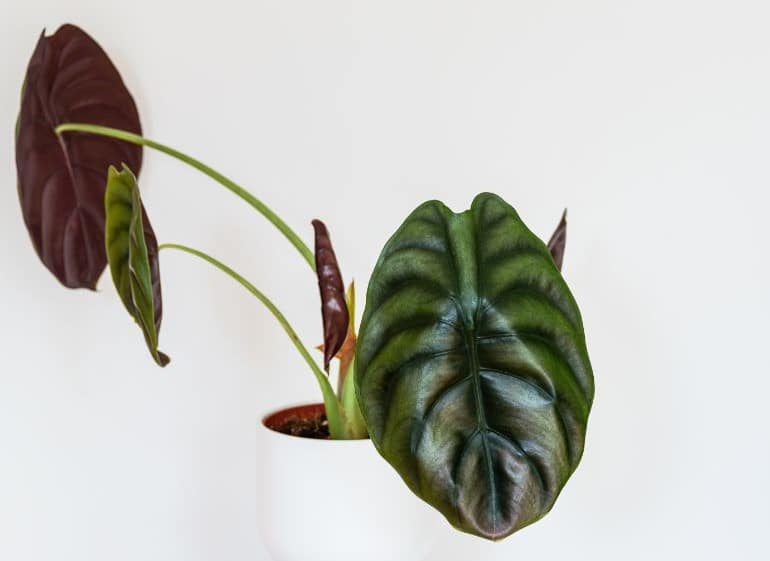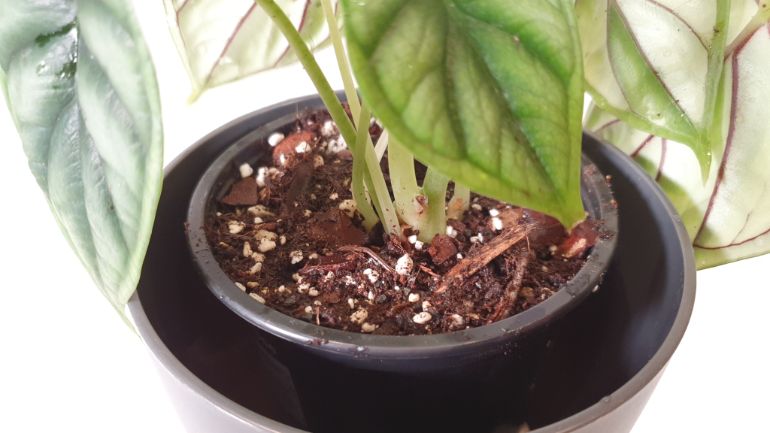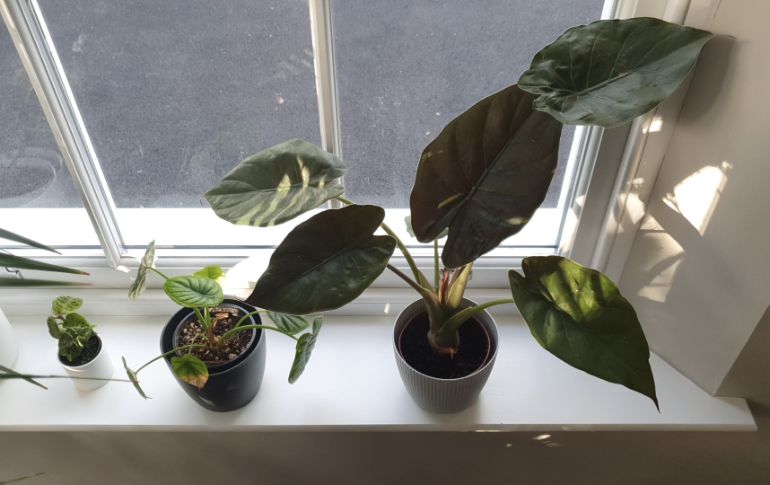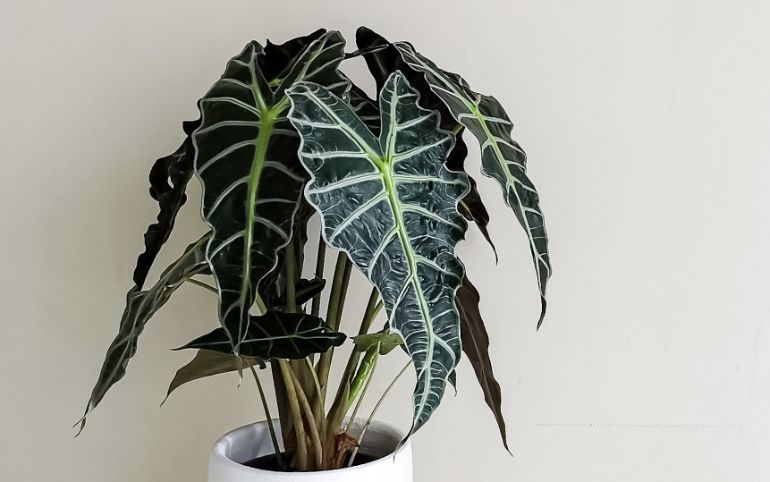Alocasias are some of the world’s most stunning houseplants – when they are happy, that is. Watering is one of the critical elements to keeping them healthy, but their needs aren’t so intuitive. This article will teach you everything you need to know about Alocasia watering, to help your plant thrive and look great.
Alocasias love humid conditions but not soil that stays overly moist. Even right after watering, the mix should never be sodden. Wait until the top two or three inches of soil have dried before rewatering. Cut back during the cool months when Alocasias usually go semi-dormant and need less water.
Overview of Alocasia Watering
Watering your Alocasia properly isn’t difficult to learn – the trouble is they don’t gladly tolerate mistakes! To avoid missteps, it helps to understand where these wonderful exotic plants come from and what they expect of their environment.
There are dozens of Alocasia species that originate in subtropical Asia and eastern Australia. All belong to the spadix-flowering Araceae family.
Note: Large, broad-leaved “Elephant Ear” Alocasia species are commonly grown outdoors as landscape plants, but they have different requirements than the smaller houseplant varieties we’re focused on.
The smaller “jewel” Alocasias naturally grow in high humidity and loose and extremely well-draining organic soil. These beautiful exotics crowd beneath the jungle canopy, perhaps on sloping terrain, and seasonally lose leaves and retreat into their tubers as conditions deteriorate with the cool season.
This natural habitat may be difficult to emulate indoors, which is one reason Alocasias are such a challenge. Areas with high humidity have a leg up; many dedicated Alocasia fans employ humidifiers or even a greenhouse to satisfy their treasured jewels.
Regardless of other factors, watering is a challenge all Alocasia growers face. The trick is to supply sufficient moisture at the right time without encouraging fungus or other pathogens. As tuberous plants, Alocasias are particularly susceptible to root rot from too much soil moisture.
General Alocasia Watering Guide
When it comes to watering, an Alocasia’s needs are different than most tropical plants. Like most of their jungle-bred cohort, they do love high humidity – but they draw the line at moist soil. Alocasias want their mix to be kept on the dry side.
This split nature is part of why Alocasias deserve their reputation for being difficult. Though they need shaded or indirect light like other tropical plants, they have to be watered more like a succulent.
Don’t water too frequently and don’t leave the soil overly moist for long. One of the main difficulties of watering an Alocasia indoors is getting their soil to dry fast enough to stave off moisture problems. A mix that dries quickly keeps the roots oxygenated and lessens the risk of rot and fungus.
Here are basic Alocasia watering tips:
- The main Alocasia killer is overwatering. They are definitely not bog plants like some of their big-leaved Colocasia cousins.
- Water routinely during the growing season, but don’t use a schedule. Instead, monitor the pot regularly.
- Depending upon the size of your container, wait until the top two or three inches of your plant’s mix has dried before rewatering.
- Though it’s important that the top of the medium dries out between waterings, you never want the soil around the rootball to go completely dry.
- Never leave your Alocasia sitting in waterlogged soil! If the mix is damp, make sure the plant receives warmth and good air circulation to speed evaporation.
- Even though underwatering is better than overwatering, Alocasias cannot survive a true drought. Don’t ever let the soil dry out completely.

Exceptions To The Rules
How to put this nicely … Alocasias express individuality in their water intake. Sometimes they drink more than at other times, and it’s not always clear why. Stay alert and always be ready to adjust your watering routine.
Dormancy
Alocasias typically shut down and enter semi-dormancy indoors during the cold season, though sometimes they just grow more slowly. They go more fully dormant in cooler conditions. The water consumption drops according to their degree of dormancy.
It’s important to watch your plant for signs of dormancy: It’s very easy to overwater when you don’t realize the plant is taking a break.
A dormant Alocasia’s soil should be kept significantly drier than when it is growing. Only partially water a dormant specimen every two weeks or so, taking the plant’s degree of dormancy into account.
When Producing A New Leaf
Another time to adjust your watering is when your Alocasia is putting out a new leaf. Its water consumption will skyrocket as the new foliage emerges in a spear and gradually unfurls.
Continue to monitor the soil even more carefully, and only water when the soil is properly dry … but be prepared to step up the pace.
Overwatering: The Hidden Alocasia Killer
Alocasias naturally store water and nutrients in their tuberous roots in order to survive droughts, but this built-in water supply makes them vulnerable to rotting in wet soil.
This means you must pay close attention to soil moisture and let the top of the soil dry between waterings. It is also why underwatering your Alocasia is better than overwatering!
Check the roots periodically to make sure no trouble is brewing. Unfortunately, your Alocasia’s leaves won’t necessarily warn you of impending problems below the soil line.
The foliage of an Alocasia with root rot may become discolored as the infection spreads; but, if you miss the earlier signs, that may already be too late. The crown will eventually fall apart after the roots have disintegrated; sometimes such a calamity is the first time its surprised owner knows there’s a problem.
Gently unpot the plant to check that the roots are pale, firm, and don’t have a bad odor. If you find signs of rot, do what you can to dry the soil immediately. Treat the plant appropriately, including trimming infected parts and repotting into a fresh, dry mix. Be more careful with watering in the future.
If your Alocasia does die back with rotting stems, don’t toss it away immediately. The pot might have other rhizomes the plant can regrow from. Let the soil dry to the appropriate level and water sparingly to give future growth a chance.
Choosing The Right Container
Only use containers that have adequate drainage. Though one central hole may be sufficient, ideally the pot should have several holes to let water exit rapidly.
If you want to use a decorative container that lacks drainage, put your Alocasia in a slightly smaller pot that does have exit holes and place it inside. Add a few pebbles at the bottom of the outer container for the inner grow pot to sit on.
Caution: Empty the outer container after watering so the plant’s roots don’t soak in the pooled runoff!
Provide Rich And Well-draining Soil

Soil can be friend or foe in your effort to properly water your Alocasia. The mix should retain some moisture but never become sodden. Many times, inadequate humidity is blamed for a struggling Alocasia when the real issue is soil that retains too much water.
It’s important for the soil to dry quickly, too. The medium’s consistency should be loose, chunky and airy. Such a mix will stay springy and let the roots breathe, and will dry rapidly enough to guard against fungal infection and root rot.
Alocasias also like a rich mix of nutrients. Their natural soil is made of fertile organic material.
Here are guidelines for proper Alocasia soil:
- Soil that has the correct consistency will drain quickly. You don’t want water to simply pour through the mix instantly, but it should only take a few seconds to pass through.
- A good soil for Alocasia will contain about 50% of an aerating element like perlite, coco coir, or coarse sand.
- The other half of a proper mix should be of organic matter like peat, compost, or humus-based potting soil.
- Alocasias prefer slightly acidic rich soil with a pH of about 5.5 to 6.5. Peat is an excellent organic amendment because it falls within this acidic range.
You should be attentive to the soil’s drainage over time, too. Some organic materials like bark or compost will gradually decompose and flatten. You can add some – but not too much – coarse sand to improve drainage. Read my guide to making or choosing houseplant soils for more info on what makes a perfect mix.
Water Quality
Another issue related to watering an Alocasia is the quality of your source. Alocasias are sensitive and can react to highly mineralized tapwater with discolored leaves or stunted growth. I’ve written more about water quality for houseplants here.
Municipal sources often treat their water with chloramines and other chlorine products which may damage delicate roots. Another potential pollutant is residual fertilizer left in the soil. Though it may not be necessary, using purified water or rainwater will solve these issues.
If you decide to use tap water, consider dechlorinating it. Setting it out overnight allows chlorine to escape – but it doesn’t affect chloramine. Instead, neutralize this persistent toxin with a few drops of aquarium dechlorinator.
When Your Alocasia Gently Weeps
Sometimes clear drops form on an Alocasia’s foliage. It seems the plant is sweating or weeping. It’s nothing to be alarmed about.
The process, called guttation, is the natural means by which the plant releases excess water. It happens when the soil is moist. Waterlogged roots push fluid out of special pores on the leaves to maintain the plant’s moisture balance.
Guttation isn’t harmful to the plant. Treat it as a signal the plant has sufficient moisture.
Alocasia Watering Tips
- Avoid giving your Alocasia’s roots a chill: use only room temperature water.
- Regularly clean the leaves. Removing dust and grime from the foliage helps maximize the plant’s transpiration, which increases water use (and dries the soil more quickly).
- Before watering, it’s a good practice to aerate the soil to keep the soil open and oxygenated. A plain fork works well … gently push the fork into the soil and “fluff” the mix by lifting the tines about halfway to vertical before pulling out. Continue over the whole soil surface.
- The careful watering an Alocasia needs may prevent adding enough water to flush the soil. To cleanse the soil of toxifying agents, it’s a good practice to regularly flush the mix by letting an excess of water flow through the medium.
Do this every month or two during the growing season when the plant has good air circulation and light. Organic fertilizers pose less risk of residue soil pollutants.
Common Questions

My Alocasia Has Recently Dropped Leaves … Should I Worry?
Losing multiple leaves at one time indicates the plant is unhappy with its environment or its care. It can happen after a relocation or repotting.
Other than losing an occasional older leaf, foliage loss often means the plant has been overwatered or left too dry. Yellowing is a common sign the soil is too wet; a plant struggling with lack of moisture often develops dry or brown areas on the leaves.
Check the soil moisture to help make a diagnosis. To be sure the plant hasn’t been damaged from overwatering, unpot it gently and inspect the roots. If they are healthy, firm, and sweet-smelling, the plant isn’t in immediate danger. Wait until the soil is properly dry before watering carefully.
Be aware that soil kept too moist or dry may be contributing to other forms of stress and causing the reaction. Evaluate other elements of its environment and care routine and make needed changes.
Why Are My Alocasia’s Leaves Drooping?
Drooping leaves are probably a sign of an unhappy Alocasia. There isn’t one answer, so you’ll need to step through a checklist of possible causes.
Over or underwatering are the most common reasons. Alocasias will droop from lack of water, but it could also be a sign of root trouble caused by overly wet soil.
Low light and pest pressures are also possible triggers, and, occasionally, nutritional deficiencies or even a seasonal light change.
Proceed carefully. The worst mistake is to automatically assume the plant needs more water. Check that the roots are healthy before rewatering and wait until the top few inches of soil has dried properly.
Once you’ve ruled out watering issues, review the plant’s environment. Don’t shock the plant with big changes in its care, but gently increase the light, warmth, humidity and see if the plant perks up.
Why Does My Alocasia Have Spots On The Leaves?
There are several possible causes for your plant’s spots:
- Check your watering routine. Colored or black spots can be caused by fungal infections fueled by wet conditions.
- Brown, dried areas can be caused by letting the soil get too dry.
- Do an inspection to rule out pests.
- Poor water quality can cause leaf spotting. Alocasias are sensitive and react to minerals and chemicals in tap water, so be sure to neutralize chlorine and chloramine before using. If the issue persists, consider using rainwater, distilled water, or another purified source.
- Salts from unused fertilizer can also contaminate the soil and lead to leaf spots.
Why Is My Alocasia Dropping Leaves?
While total leaf loss is hardly a good sign, don’t give up hope. Alocasias grow from tubers that store energy, so there’s a chance the plant can recover. It is natural for Alocasias to fade back into their tuber as temperatures cool and growing conditions diminish.
The best course is to put your leafless Alocasia in a warm spot and water it sparingly like any dormant plant. Alocasias are well known for staging strong comebacks!
Last Word
If you can master the art of Alocasia watering, you won’t have issues with watering other houseplants. Alocasias demand that you respond to their needs and provide what they want, when they want it. Thankfully, Alocasias are some of the most interesting and beautiful houseplants I own, and are worth every bit of effort required to keep them happy.
You can read more about growing Alocasias in some of the articles below. Alternatively, check out my book, “Houseplants Made Easy” to master the art of growing beautiful houseplants that thrive year after year.

